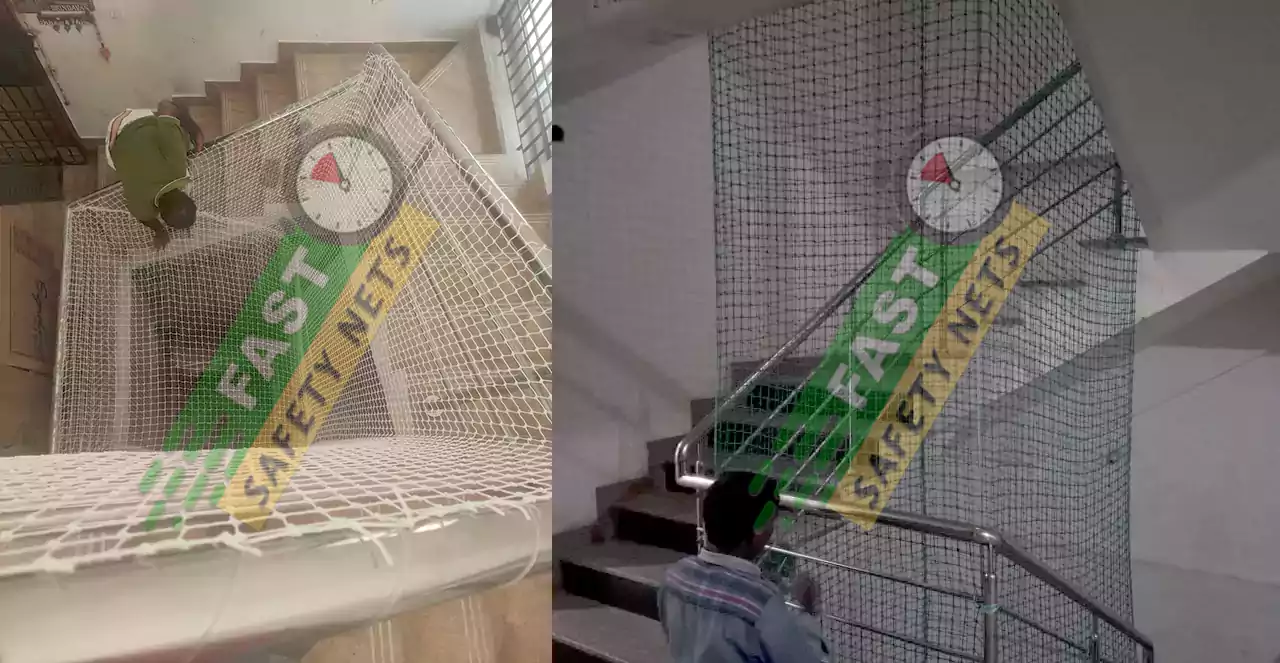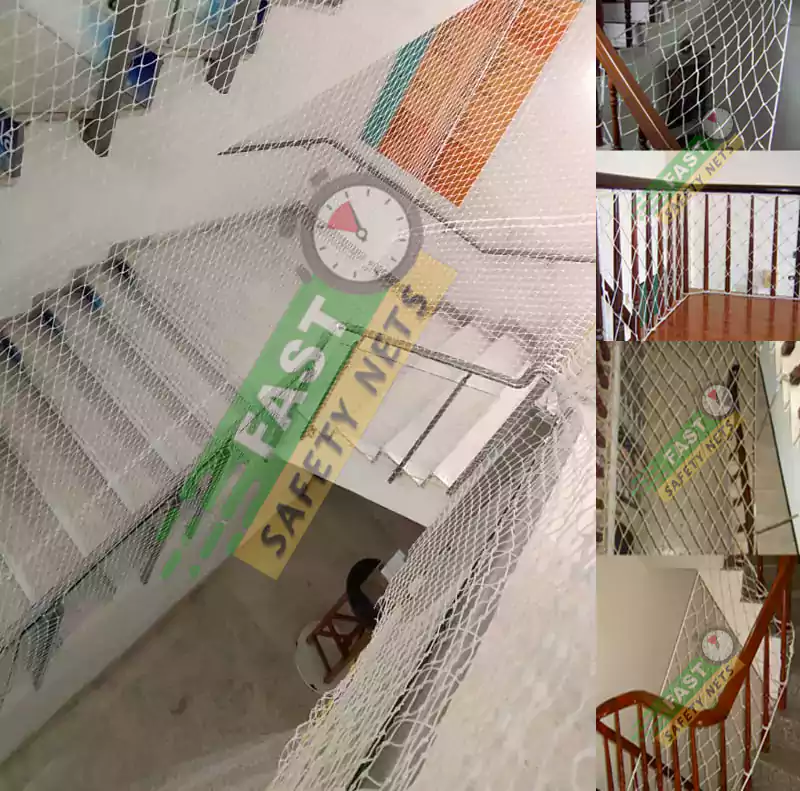
Staircase safety nets, also known as stairwell safety nets or stair railing nets, are protective barriers installed along the open sides of staircases to prevent falls and accidents. They are typically made of durable materials such as nylon, polyethylene, or steel wire mesh and are designed to withstand impact and pressure. Staircase safety nets are available in various sizes, configurations, and styles to accommodate different staircase layouts and architectural designs. These nets provide an essential safety feature, especially in homes with children or elderly individuals, enhancing overall safety and peace of mind.
These nets are installed vertically or horizontally along the edges of staircases, creating a barrier that prevents people, children, and pets from falling or slipping through the openings. Staircase safety nets are often used in residential homes, apartments, schools, commercial buildings, and public facilities where staircases pose a risk of accidents.
Staircase safety nets serve as essential safety measures in homes, apartments, and buildings with staircases, addressing various safety concerns and mitigating the risk. Let's explore the reasons why these safety nets are necessary:
Preventing Accidents and Falls on Staircases: One of the primary purposes of staircase safety nets is to prevent accidents and falls on staircases. Staircases present inherent risks, particularly in homes with open staircases or elevated platforms where individuals may accidentally step off the edge or lose their balance while ascending or descending. Staircase safety nets act as protective barriers along the open sides of staircases, creating a physical barrier that prevents individuals from falling or slipping through the openings. By providing a secure boundary, these nets significantly reduce the risk of falls, slips, and trips on staircases, promoting safety for occupants of all ages
Protecting Children and Pets: Children and pets are particularly vulnerable to accidents on staircases due to their curious nature and lack of awareness of potential hazards. Staircase safety nets play a crucial role in protecting children and pets by preventing them from accessing the open sides of staircases and falling off or getting stuck between railings. These nets create a safe environment for children to navigate staircases independently and for pets to move freely without any risk. By installing staircase safety nets, parents and pet owners can ensure the safety and well-being of their loved ones and provide peace of mind knowing that potential hazards are mitigated.
When selecting staircase safety nets, it's essential to consider various factors to ensure they meet the specific requirements of your staircase layout and provide effective fall prevention. Here's a guide to help you choose the right staircase safety nets:
1. Types of Nets Suitable for Staircases:
Nylon Nets: Nylon nets are lightweight, durable, and resistant to UV rays, making them suitable for indoor and outdoor use. They offer excellent strength and flexibility, allowing for easy installation and customization to fit different staircase layouts.
Polyethylene (PE) Nets: Polyethylene nets are known for their high tensile strength, durability, and resistance to weathering and environmental conditions. They provide reliable protection against falls and accidents on staircases while maintaining visibility and airflow.
2. Considerations for Material, Size, and Mesh Density:
Material: Consider the environmental factors, such as indoor or outdoor use, exposure to sunlight and moisture, and the level of durability required, when choosing the material for staircase safety nets. Nylon and polyethylene nets are suitable for most residential and commercial applications, while steel wire mesh nets offer enhanced strength and durability for industrial settings.
Size: Measure the dimensions of your staircase accurately to determine the size of safety nets required. Consider factors such as length, width, and height to ensure complete coverage and protection along the open sides of the staircase.
Mesh Density: Choose a mesh density that provides adequate fall protection while maintaining visibility and airflow. Higher mesh density nets offer increased protection against smaller objects and debris but may reduce visibility, while lower mesh density nets provide better visibility but may offer less protection against smaller objects.
3. Customization Options for Staircase Layouts:
Many staircase safety nets are customizable to fit different staircase layouts and architectural designs. Manufacturers offer a range of customization options, including net size, shape, color, and installation method, to accommodate various staircase configurations and aesthetic preferences.
Consider consulting with experienced professionals or manufacturers to discuss customization options and tailor the safety nets to your specific staircase layout and requirements. Customized safety nets ensure optimal fit, functionality, and aesthetics, enhancing safety and visual appeal in your home or building.

Staircase safety nets are essential safety features that play a vital role in preventing accidents and falls on staircases, particularly in homes, apartments, and buildings with open staircases or elevated platforms. Let's explore the situations when it's necessary to use staircase safety nets: .
1. Installation in Homes, Apartments, and Buildings with Staircases: Staircase safety nets should be installed in homes, apartments, and buildings with staircases to ensure the safety of occupants, especially children, seniors, and individuals with mobility issues. Open staircases or elevated platforms pose inherent risks of falls and accidents, making it crucial to implement safety measures such as safety nets along the open sides of staircases. By installing staircase safety nets, property owners can create a safe and secure environment for occupants to navigate staircases with confidence, minimizing the risk promoting peace of mind.
2. After Incidents or Accidents on Staircases: After incidents or accidents on staircases, such as falls, slips, or near misses, it's essential to assess the safety of the staircase and implement measures to prevent future accidents. In cases where accidents have occurred due to gaps or openings along the sides of staircases, installing staircase safety nets becomes imperative to prevent similar incidents in the future. Safety nets act as protective barriers that prevent individuals from falling or slipping through the openings, reducing the risk associated with staircases.
3. During Renovation or Construction of Staircase Areas: During renovation or construction projects involving staircase areas, it's essential to prioritize safety and implement measures to prevent accidents and falls on staircases. Staircase safety nets can be installed temporarily during renovation or construction activities to provide fall protection and mitigate the risk of accidents for workers and occupants accessing the staircase areas. By installing safety nets during the renovation or construction phase, property owners demonstrate their commitment to safety and ensure a safe working environment for contractors and workers involved in the project.
Installing staircase safety nets is a straightforward process that requires careful preparation, the right tools and equipment, and adherence to a step-by-step installation process. Let's explore how to install staircase safety nets effectively to ensure fall prevention and enhance safety on staircases:
1. Preparation and Assessment of Staircase Area:
Measurements: Begin by measuring the dimensions of the staircase area accurately to determine the size of safety nets required. Measure the length, width, and height of the open sides of the staircase to ensure complete coverage and protection.
Assessment: Assess the condition of the staircase area, identifying any obstacles, protrusions, or irregularities that may affect the installation process. Ensure that the staircase area is clean, dry, and free from debris or obstructions.
2. Tools and Equipment Required:
Safety Equipment: Prioritize safety by wearing appropriate personal protective equipment (PPE), including gloves and safety glasses during the installation process.
Installation Tools: Gather the necessary tools and equipment for installing the safety nets, including a ladder or scaffolding for reaching elevated areas, a drill or screwdriver for securing the nets, and measuring tape for taking accurate measurements.
3. Step-by-Step Installation Process for Fall Prevention:
Step 1: Positioning the Safety Nets: Start by positioning the safety nets along the open sides of the staircase, ensuring that they cover the entire length and height of the railing or balustrade. Use clamps or temporary fasteners to hold the nets in place temporarily.
Step 2: Securing the Nets: Once the safety nets are properly positioned, secure them in place using screws, bolts, or cable ties. Attach the nets securely to the staircase railing or balustrade at regular intervals to ensure stability and strength.
Step 3: Adjustments and Tensioning: Make any necessary adjustments to the tension and alignment of the safety nets to ensure a tight and secure fit. Tension the nets evenly to eliminate sagging or gaps that may compromise their effectiveness.
Step 4: Final Inspection: Once the safety nets are securely installed, perform a final inspection to ensure that they are properly aligned, tensioned, and securely fastened. Check for any loose or protruding fasteners and make adjustments as needed.
Expertise and Experience: Fast Safety Nets Chennai has extensive experience in the installation of safety nets, including staircase safety nets. With a team of skilled professionals and specialized equipment, Fast Safety Nets Chennai ensures the highest quality installations tailored to each client's needs.
Cstomized Solutions: u Fast Safety Nets Chennai offers customized solutions for staircase safety nets, considering factors such as staircase layout, material preferences, and aesthetic requirements. Each installation is tailored to meet the specific safety needs and design preferences of the client..
High-Quality Materials:Fast Safety Nets Chennai uses high-quality materials for staircase safety nets, ensuring durability, longevity, and effectiveness. Whether nylon, polyethylene, or steel wire mesh, the materials are selected for their strength, weather resistance, and UV stability, ensuring reliable fall protection.
Staircase safety nets act as protective barriers along the open sides of staircases, preventing individuals from accidentally stepping off the edge or slipping through the gaps in the railing. The nets create a physical barrier that absorbs impact and reducing the risks associated with staircases.
Copyright 2025 pigeonbalconynetting.com | All Right Reserved . Google Ads & SEO, Website Designed and Developed by isewis Technologies - www.isewis.com